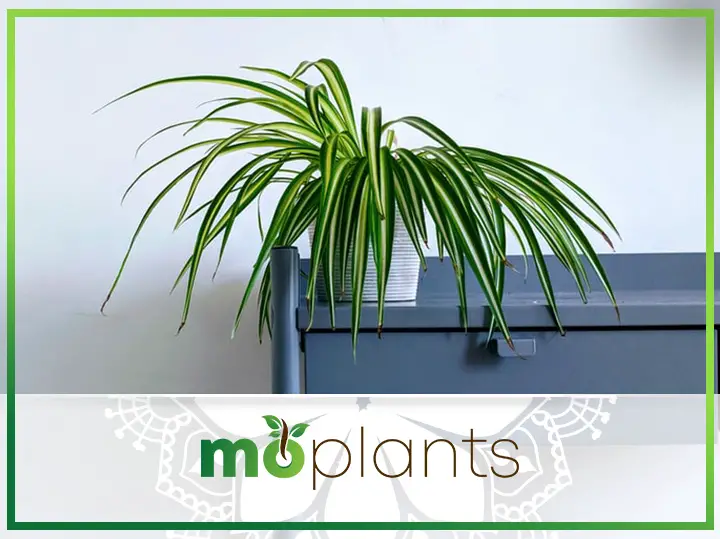Though its name may sound like an arachnophobe’s worst nightmare, the beautiful and elegant spider plant is anything but creepy – and no, it doesn’t harbour spiders either.
With its slender spear-shaped leaves cascading over the edge of its pot and striking star-shaped plantlets adorning the edge of the stems, the spider plant is one of the most aesthetically pleasing and adaptable houseplants. Whether you place it in a hanging basket or a small traditional container, this green beauty would be a perfect addition to any room in your home.
Native to the rainforests in South Africa, this tropical plant is adored for its vibrant foliage and undemanding nature. Since spider plant is particularly easy to grow and care for, it makes an excellent companion for beginners and those without green fingers. Even if you don’t water it for a week or two, this plant will continue to thrive, forgiving you for the oversight.
This statement plant can also add a touch of elegance and sophistication to your home décor. Additionally, it can improve the indoor environment with its air-purifying qualities.
Introduction: Spider Plant
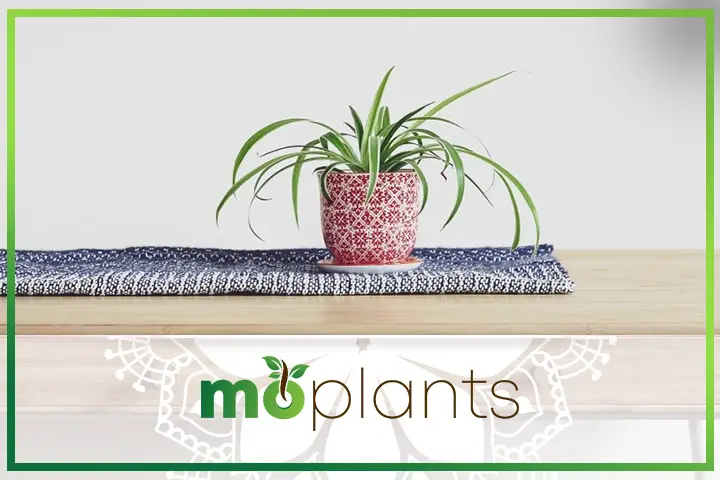
The botanical name of the spider plant is Chlorophytum comosum, and it belongs to the asparagus family. The beautiful plant gets its unique name from its distinct spider-shaped plantlets or offsets, also called pups or spiderettes. Spider plants’ most common aliases include spider ivy, ribbon plant, airplane plant, and Bernard’s lily.
The resilient nature of this tropical plant enables it to survive in less-than-perfect conditions. Thanks to its thick and fleshy roots, this plant can retain a lot of moisture and continue to grow even if it doesn’t receive fresh water for some time. Spider plant can also produce elegant white flowers that resemble small stars. Once these flowers fall off, tiny offsets take their place and eventually grow their roots. You can remove these spiderettes to grow a new plant or trim them to make the mother plant look fresh and well-kempt.
Moreover, spider plant has long leaves that can grow up to 1.5 feet in length. These leaves are usually striped, adorning different shades of green and white. However, some plants may only have green leaves. Being native to rainforests, this plant thrives in warm temperatures and does not fare well when exposed to cold weather. In addition, it grows at a moderately fast pace.
There are several reasons why people prefer growing spider plants indoors. Firstly, they can purify the indoor air, ensuring your home remains healthy and free of pollutants. Secondly, the spider plant is pet-friendly. It does not contain strong toxins that may be harmful to felines, canines, and other pets. They are also safe for humans.
How to Grow Spider Plant

Decorating your windowsill or mantle with spider plants can add a touch of luxury and elegance to your interior design. This houseplant can add a splash of color and texture to the living room, bedroom, hallway, and other parts of your home.
Do you want to learn how to grow spider plants indoors? We’ve got you covered.
Position
Spider plants flourish in bright spots that don’t receive direct sunlight. You can hang this plant in a shaded spot on your patio, display it on your coffee table, or put it on your desk. Regardless of where you place it, it will look good as long as it’s away from the air conditioning vents.
Ideal Temperature
These tropical plants prefer temperatures between 55 and 80 degrees Fahrenheit. The spider plant thrives in warm conditions, but you must protect it from frost and drafts. In other words, you can place your plant outdoors in summer, though you must make sure to bring them indoors once the weather starts to get cooler.
Humidity Level
To grow spider plant indoors, you must provide them with a moderately warm and humid environment. If you live in a dry area, consider investing in a humidifier for your houseplant. You can also mist its leaves to ensure the plant doesn’t get too dry.
Exposure to Sunlight
Harsh sun rays can damage your plant and cause its leaves to turn crispy at the edges. Therefore, you must make sure to keep it in a brightly lit spot that doesn’t get direct sunlight. Moreover, please don’t place your spider plant in a dark or heavily shaded corner of your home, as this may affect its growth and cause the leaves to lose their color.
Watering Frequency
These stylish plants enjoy moist soil. However, that does not mean you should keep the soil soggy or waterlogged. You should ideally water the plant once a week or when the soil starts to get dry.
Additionally, despite its easygoing nature, the spider plant is sensitive to chlorine, fluoride, and other chemicals commonly found in tap water. So, it would help if you considered using distilled water for your houseplant.
Potting Mix
If you’re looking to grow spider plant, you must know that it prefers neutral soil pH but can also grow well in slightly alkaline or slightly acidic soil. When buying the potting mix for this houseplant, please make sure to choose well-drained soil with low level of salt.
Infographic
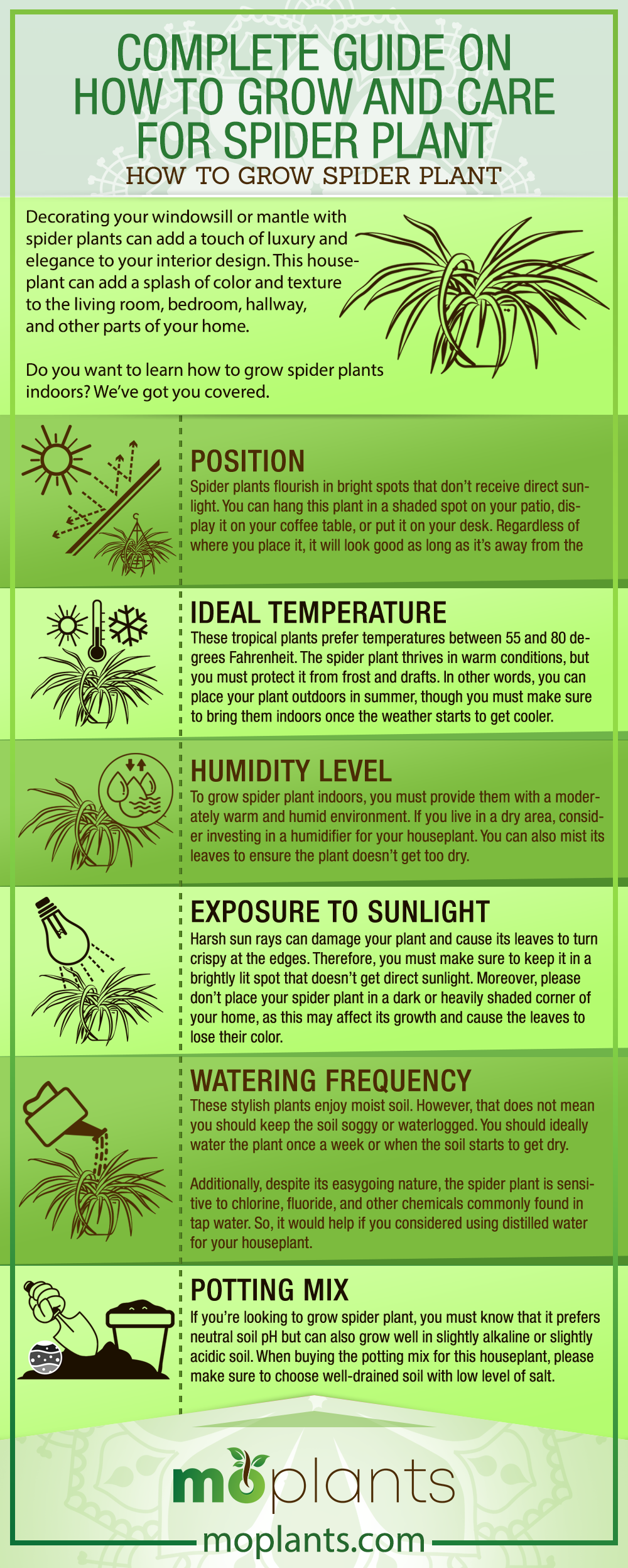
Spider Plant Propagation Method
Spider plants are not difficult to propagate.
If you want to grow a new plant from the mother plant, you have to wait for the small plantlets to appear on the edge of the flower stems. Once these spider-shaped offsets develop their roots, take a sharp knife and carefully cut them off the stem. Make sure the roots remain intact as you place them in a separate container with fresh potting mix. Water the soil so it stays moist until the baby plant establishes its root system. This is probably the easiest spider plant propagation method.
Alternatively, you can dig the roots of a mature spider plant and divide the root balls into two or more sections without damaging them. You can replant these fully-grown sections into different pots and place them in different parts of your house.
Spider Plant Care Tips
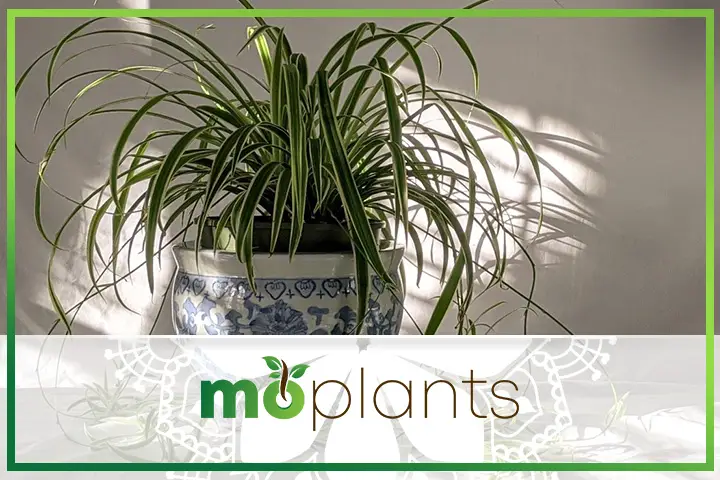
Like all houseplants, your spider plant will also prosper if you show it some love and affection.
Here are some spider plant care tips that you may find helpful.
Pruning and Trimming
Being moderately fast growers, the vibrant leaves of spider plants can take over the entire pot and drape down its sides if you don’t trim and prune them occasionally. Depending on your preference, you can cut off the plantlets or trim the leaves back to the base to keep the plant from turning into a wild bush.
Balanced Fertilizer
You can feed spider plants with a water-soluble houseplant fertilizer every two to three weeks in the spring and summer seasons. During winters, fertilizing it only once every two months would be sufficient. Please remember that too much fertilizer can result in leaves turning brown at the tips, so it’s better to feed the plant in moderate intervals.
Wiping and Cleaning
The dust and debris on the foliage of your spider plant will not only take away from its aesthetic beauty but also affect its ability to remove toxins from the air. You can either wash the plant with clean water or wipe it with a wet cloth. This spider plant care tip will make the foliage look healthy and shiny.
Repotting
As per the rule of thumb, you should always buy a pot that is at least a few inches larger than the root ball. It must also have a drainage hole to get rid of excess water.
Typically, spider plants outgrow their pots every two years, though the period can be slightly longer or shorter depending on your plant’s growth. If you see the roots coming out of the drainage hole or can see them on the surface of the soil, it’s a tell-tale sign that your spider plant needs a bigger container.
The best time for repotting your plant is in spring. All you need to do is remove the plant from its pots and place it into the new one without damaging the root ball. Don’t forget the fill the container with fresh potting mix and water it until the soil is moist.
Common Spider Plant Problems and How to Solve Them
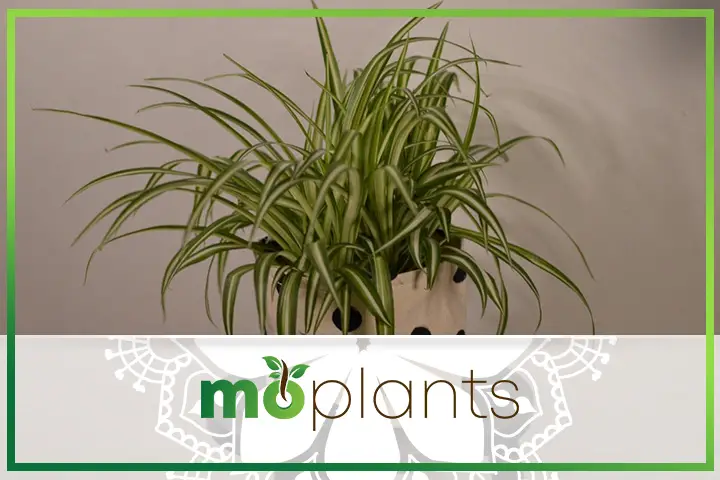
Now that we know the essential spider plant care tips, it’s time to look at some of the most common problems you may face while growing this gorgeous houseplant.
Leaves Fading and Losing Color
There are two main reasons why the leaves of your spider plant may be losing their green stripes: lack of water and low humidity level.
If you notice any discoloration on the narrow leaves or if they appear droopy, you should increase your watering frequency. Moreover, mist the leaves regularly to ensure the plant remains fresh and hydrated.
Leaves Turning Brown on the Edges
The impurities in the water are the most common reason behind these brown edges. The chlorine, fluoride, and other chemicals present in your tap water can cause a buildup in the soil, resulting in foliage turning brown or burning at the tip. Fortunately, you can easily fix this problem by watering the plant with filtered water. If that’s not possible, pour some tap water into a container and leave it overnight to relieve some of the chlorine. You can use it to water your spider plant in the morning.
Lack of humidity and dry soil can also result in brown leaves. Therefore, you may want to water the plant more frequently and mist it daily to bring the foliage back to life.
Common Pests and Diseases
Spider plants are not particularly prone to any diseases. However, if you keep them in a heavily shaded area and don’t clean them often, they may become vulnerable to common pest infestation. If you notice aphids, whiteflies, and spider mites on your plant, rinse the leaves thoroughly with water and use a mild insecticide to keep them healthy.
Infographic
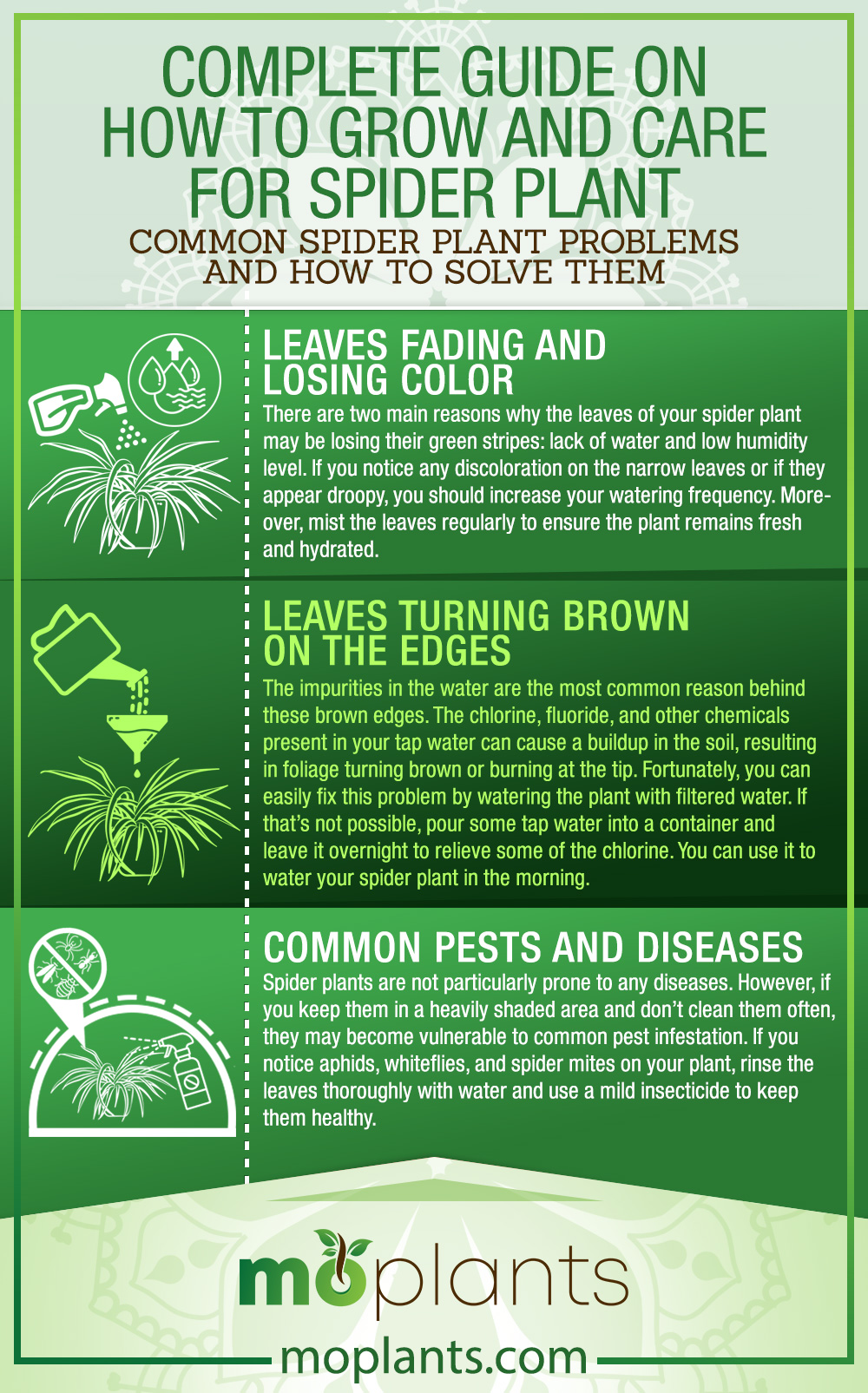
Spider Plant Varieties
There are more than 65 varieties of spider plants found in South African rainforests. While you can’t find all of them in your local nursery, here are a few popular ones that you can easily get your hands on.
Vittatum Spider Plant
The trendy Vittatum spider plant has bright green slender leaves with a creamy-white stripe down the middle surrounded by thinner green margins. The white stems of this plant are among its most distinct features.
Hawaiian Spider Plant
The Hawaiian spider plant only has variegation on its new leaves. As the leaves mature, their variegation begins to fade, giving the plant a distinct appearance.
Bonnie Spider Plant
Bonnie spider plants are perhaps the most interesting of the bunch. These plants are relatively compact but have leaves that curl and twist along the tip. The green margins on the leaves envelope a broad cream-colored stripe, which gives the plant a classic appearance. Moreover, this is one of the unique spider plant varieties as it produces yellow flowers.
Variegated Spider Plant
This is perhaps one of the most popular spider plant varieties. Its leaves have dark green stripes in the middle with cream-colored stripes on either side. In addition, the variegated spider plant has green stems. On the other hand, the bonnie variegated spider plants have loosely curled leaves.
Spider Plant FAQs
These are some of the most frequently asked questions about spider plants.
Is spider plant pet-friendly?
Spider plant is safe for cats and dogs. However, if consumed in a large quantity, the plant can cause an upset stomach, discomfort, or even make your furry companion fall sick. So, if you have curious pets who like to munch on houseplants, consider placing your spider plant above the refrigerator, on the mantel, or another high place.
How much sunlight does a spider plant need?
Spider plant may tolerate lower light conditions, but it needs bright light to grow. However, you must avoid placing this houseplant in direct sunlight as it may burn the foliage.
What are the benefits of spider plants?
This houseplant has brilliant air-purifying properties. It can help improve your health by removing harmful toxins such as carbon monoxide and formaldehyde from the indoor air.
Do spider plants attract spiders? This is a common misconception. The spider plant does not attract spiders. The plant gets its name from its offshoots that develop wiry roots that look like spiders.

